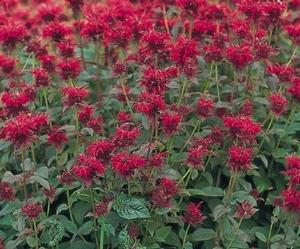Printed at http://www.newmoonnursery.com/index.cfm/
Monarda didyma
Scarlet Bee Balm
Native to North America
FIRST IMPRESSIONS: Monarda didyma is a sturdy perennial wildflower that expands to form upright clumps. Plants bear deep green aromatic leaves on strong square stems. In summer, they are topped by showy rounded clusters of red to purplish tubular flowers. Pollinators flock to the blooms in sunny or partially shaded settings with average or moist well drained soils.
HABITAT & HARDINESS: Monarda didyma occurs from Quebec, New Brunswick and Maine to north Georgia and west to Ontario, Minnesota and Missouri. This is mainly a Northeastern species with the greatest distribution in montane habitats from Maine to Pennsylvania and south into the Appalachians.
This species is indigenous to wet meadows, moist open woods, woodland borders, thickets and disturbed sites.
Plants are hardy from USDA Zones 4-7.
PLANT DESCRIPTION: Monarda didyma is an upright perennial that expands into colonies from vigorous rhizomes.
Stems are pubescent, green and square with occasional branching. The aromatic leaves are arranged opposite from each other on 1” petioles along the stems.
Leaf blades are deep green and heart shaped to ovate. They are 5” long and 2” wide with toothed edges and pointed tips.
The stems terminate in rounded 3-4” flower clusters with several red or purple tinted leaf-like bracts beneath.
The flowers are tubular and over 1” long. Each corolla tube is actually a ring of united petals with a scarlet red or purplish color. The tubes are lightly pubescent with lobes toward the tip and exserted stamens.
The flowers are born in a ring on each dense head-like cyme. The lobes and stamens of individual flowers give the flower clusters a ragged appearance.
Blooming begins in summer and lasts for about 6 weeks and is followed a crop of ovoid nutlets.
Plants grow 2-3’ tall with an equal spread.
CULTURAL & MAINTENANCE NEEDS: Monarda didyma thrives in sun or part sun and moist acid humus rich soil. Plants tolerate clay, sand and wet soils.
This species blooms more vigorously if divided in spring or fall every 3-4 years.
Foliage is prone to powdery mildew especially during rainy weather. Irrigation during drought and pruning to promote air circulation help to enhance the resistance.
The aromatic foliage is unpalatable to deer, rabbits and other herbivores.
LANDSCAPE USES: This is a good choice for a Wildlife Garden, Cut Flower Garden, or Meadow. Plants are also used as Butterfly Nectar Plants or as part of a Grouping or Mass Planting. Monarda didyma has Showy Blooms and is appropriate for Cottage Gardens, Deer Resistant Plantings, Low Maintenance Plantings and Perennial Borders.
COMPANION & UNDERSTUDY PLANTS: Try pairing Monarda didyma with Coreopsis tripteris, Rudbeckia hirta, Liatris spicata, Schizachyrium scoparium and Andropogon gerardii.
Monarda didyma ‘Jacob Cline’ has similar appearance and culture and could be substituted in garden situations.
TRIVIA: Bumblebees, swallowtail butterflies and hummingbirds sip nectar from the flowers. Caterpillars of several moth species feed on the foliage. The aromatic leaves and stems are unpalatable to deer and other herbivores.
Monarda didyma was a popular substitute for “real tea” (Camellia sinensis) after the Boston Tea Party. True tea was imported from Britain and taxed by the Crown. This species is sometimes called Oswego tea for the Native American tribe who made great use of it.
Height:
2-3 ftSpread:
2-3 ftSpacing:
2 ftUSDA Hardiness Zone:
4-7Bloom Color:
RedMonarda didyma Characteristics
Attracts Wildlife
- Butterflies
- Pollinators
- Hummingbirds
Attributes
- East-Coast Native
- Dried Flower
- Cut Flower
- Clay Soil
- Naturalizing
- Interesting Foliage
- Rain Garden
- Favorite
Exposure
- Full Sun to Partial Shade
Deer Resistant
- Deer Resistant
Flowering Months
- August
- July
Foliage Color
- Green
Groundcover Foot-Traffic Tolerances
- Light
Growth Rate
- Medium
Juglans nigra Tolerance (Black Walnut)
- Yes
Salt Tolerance
- Medium
Season of Interest (Foliage)
- Summer
- Spring
Soil Moisture Preference
- Moist to Wet

